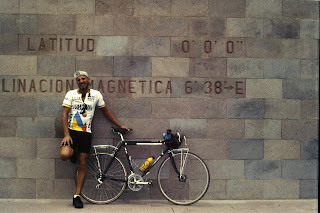Jackie went hacking off on his bike for a training run while I went down for a hot shower and breakfast. On his way back Jackie cycled through a hail of stones and clouds of CS gas as he passed through a riot at the University! I then went into the market and bought a new nylon sports bag for 2,500 Sucres. My old one is on it’s last legs, having split several times now and the zip is fucked. It is a nice blue bag which was made in Korea and had something about the Olympic Games written in pidgin English on the side.
It is a warm sunny morning for a change and there is a big military presence on the streets. I packed my bags and joined Hannes in the restaurant for fruit salad. Then we bid farewell to everyone. “The bastard Englishmun’s desertin’ me”, said Jackie as we shook hands.
It will be boring without him. Last night he told us that on his return from India he was brown, shaven-headed and emaciated by hepatitis. “I looked like fookin’ Ghandi, yer ken?”. He was sitting on the side of the road when an old woman came up and tapped him on the shoulder and gave him a Kit Kat!
We walked quickly to the main bus terminal where there were three floors and rows of windows for each destination. We bought tickets to Otavalo for 165 Sucres for a bus leaving almost immediately at 10:40 hrs.
Otavalo, capital of Otavalo Canton, has a population largely made up of the Otavalo indigenous group. It is located in Imbabura Province of Ecuador. The town has an elevation of 2,532 metres (8,307 feet). It is surrounded by the peaks of Imbabura (4,630 metres (15,190 ft)), Cotacachi (4,995 metres (16,388 ft)), and Mojanda volcanoes.
The bus initially seemed to do a tour of the Quito suburbs picking up passengers and then we headed north. Each valley we passed through was different. The first was arid with scrub bushes and grey sand, the next fragrant with the scent of pine from the forests.
The landscape became hillier and greener with patchwork fields that could be in Wales. Finally, we saw the lake and volcano which are above Otavalo. The driver hammered into the many bends with the apparent intention of seeing how fast the bus could take the bends without turning over.
This was in addition to the now familiar crazy overtaking in the most inappropriate and dangerous places. We finally pulled into the town square where we alighted from the bus and walked down Calle Roca to the Residentilisa Belita.
Here we got excellent clean spacious rooms for 400 Sucres each. Number 3, my room was simply but excellently furnished with a tourist poster of Cuenca on the white walls. I did some washing (laundry) just as a thunderstorm started.
As the rain abated Hannes and I walked into town for a meal. We ate in a pleasant local café and chatted to a couple from Herefordshire. After eating we strolled around the town looking in the craft shops and munching peanuts and Milky Bar chocolate.
It was very quiet and seemed like a Sunday afternoon. There were a few desultory stalls in the market and a few indigenous Indians in trilby hats wandering about, as well as a few dogs. The main square has palm trees and is very Spanish colonial.
Back at the hotel we chatted with the friendly owner and watched the clouds clear from the summit of the volcano. The owners dog cheerfully tugged at the sheets drying on the washing line while the owner went on an insect hunt with his fly swatter.
At 19:00 hrs. we walked down into the town for some food and a few drinks. After a grand tour we concluded that there was no exiting nightlife in Otavalo on a Monday night. Most of the bars and restaurants were empty. We finished up in a Korean restaurant for Chop Suey and a beer.
At 21:00 hrs. we were back in our rooms, bloated and tired. Otavalo has a quiet tranquil atmosphere, and the people are very friendly, quick to smile at you. I finished off the last few pages of my book “Whirlwind” and turned in at 22:00 hrs.










































